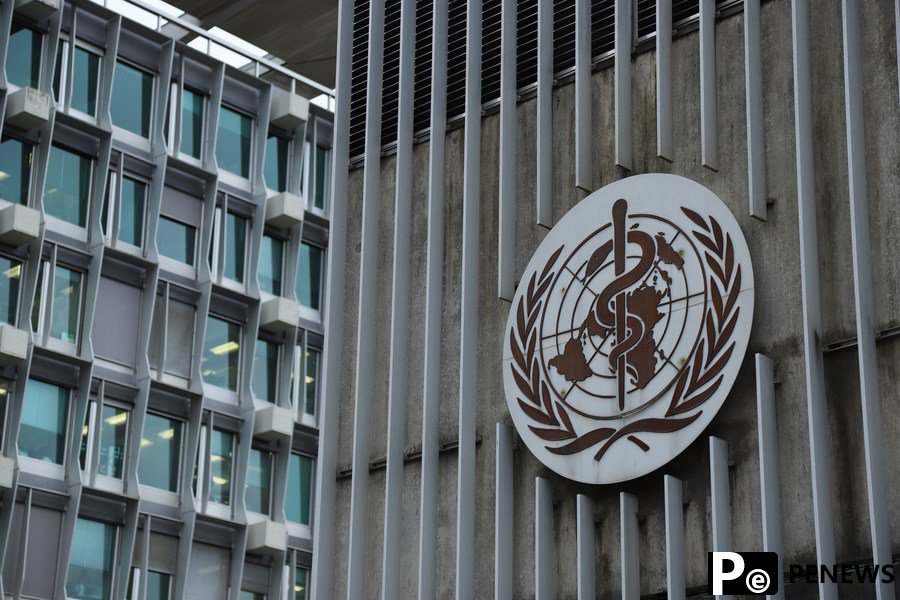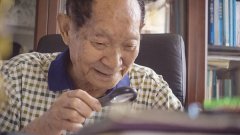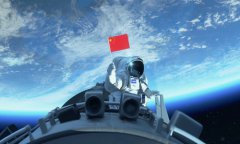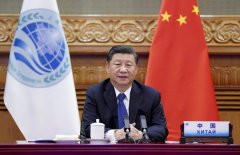
Photo taken on Jan. 30, 2020 shows the headquarters of the World Health Organization (WHO) in Geneva, Switzerland. (Xinhua/Chen Junxia)
The National Health Commission of China on Monday released the full transcript of a joint China-WHO press conference on the WHO-convened Global Study of Origins of SARS-CoV-2, which was held on February 9.
Below is the full text:
Ladies and gentlemen, dear friends, good afternoon. Welcome to the joint China-WHO press conference of WHO-convened Global Study of Origins of SARS-CoV-2: China part. This is Mi Feng, the spokesperson of China National Health Commission.
Since COVID-19 became a global pandemic, WHO has been actively promoting the international cooperation in terms of the COVID-19 response. China has always been showing firm support to WHO in terms of unleashing the role of WHO in the leadership of the global COVID-19 response.
With the consensus based on negotiation between two sides, China and WHO have conducted joint research of the SARS-CoV-2 global origin tracing: China part. Since the arrival of international expert teams in Wuhan on January 14th, 2021, the joint expert team has been working as three groups, respectively the group of epidemiology, molecular epidemiology and bioinformatics, animal and environment. The experts have been working in the forms of video conferences, on-site interviews and visits and data analysis, as well as discussions. They have conducted systematic and full-fledged research. The joint expert team have already concluded the China part of scientific research related to origin tracing in Wuhan according to the original plan.
During this period, Mr. Ma Xiaowei, the Minister of National Health Commission has been discussing and having extensive communication with Doctor Tedros, the Director General of WHO through telephone. They thoroughly exchanged ideas in terms of the scientific cooperation on the origin tracing.
For today's conference, we have guest participants on the podium with us from the joint expert team and they are Mr. Peter Ben Embarek, from WHO, food safety expert and also Madam Marion Koopmans, the member of the joint expert team and also the team leader of the molecular epidemiology group. And also professor Liang Wannian from Tsinghua University. He is the team leader of the Chinese side of the joint expert team.
They will present the work that the joint expert team has done and introduce to the public and to the press of the updates and highlights of SARS-CoV-2 origin tracing of this joint study and also they are going to answer your questions. Consecutive interpretation will be offered in today's press conference. So journalists can ask question either in Chinese or in English.
First I would like to invite professor Liang Wannian, the team leader from the Chinese side to introduce relevant information of this joint study of origin tracing in Wuhan.
Dear friends from the press, good afternoon. On behalf of the team leader from the Chinese side of the China-WHO joint expert team of the SARS-CoV-2 origin tracing research. I would like to give you a brief introduction of the major research process and also the key findings of our endeavor in our recent joint study. With regards to the conclusions and future recommendations, these two parts will be introduced by the team leader from the WHO expert team, Doctor Peter Ben Embarek.
This joint research is the China part of the WHO-convened Global Study of Orgins of SARS-CoV-2. The joint research report is based on the relevant research, a crystallization from the Chinese and international scientists in the past. And also the literature review of the previous research and also the analysis will be also included in this joint report.
In May 2020, the 73rd World Health Assembly requested the Director General of the World Health Organization to work with the partners to identify zoonotic source of the causative virus of COVID-19, and the route of its introduction to the human population, including the possible role of the intermediate hosts. The aim was to prevent reinfection with the virus in animals and humans and prevent the establishment of a new zoonotic reservoir, as well as to reduce further risk of emergence and transmission of zoonotic diseases.
In July 2020, WHO and China began the ground work for the studies to identify the virus origins. The agreed terms of references or ToR defined the scope of the studies, the main guiding principles and the main expected deliverables. These ToRs define an initial phase of short-term studies to better understand how the virus might have been introduced and started to circulate in Wuhan. The WHO Secretariat and the Chinese Government have jointly set up an international multidisciplinary team to design, support and conduct these studies to contribute to the tracing of the origins of SARS-CoV-2 and the route of its transmission to human beings. The work of the joint international team was set it as the ground for origin tracing work in other parts of the world.
Therefore, the global origin tracing work will not be bound to any location and may evolve geographically as increasing amount of evidence is generated and science-based hypotheses keep evolving . The overall results and findings will help to improve global preparedness and effective response to SARS-CoV-2, and emerging zoonotic diseases of similar origins.
The joint international team comprises 17 Chinese experts and 17 international experts from ten other countries. And they represent WHO, World Organization of Animal Health, partners in the global outbreak alert and response network (GOARN). The joint study team carries out a research over a 28-day period from January 14th to February 10th 2021 in Wuhan.
The joint expert team through its three working groups, reviewed and discussed together the progress made by Chinese experts in phase one studies in the following three areas: epidemiology, animals and environment, molecular epidemiology and bioinformatics.
In addition to the three working groups, the joint international team received detailed presentations on relevant topics to help inform its work and undertook a series of site visits and interviews with key informants.
Now I would like to give you a brief introduction of the key findings of our joint study. The first part of my introduction will be the result of the molecular epidemiology study.
As most of the emerging viruses have their origins in animals, in order to gather more insights of the process of virus spill-over and global spread, it is necessary to understand the diversity and evolution of viruses in an animal reservoir, the interactions between animals, environment and humans and relevant factors contributing to the efficient human-to-human transmission.
Generally speaking, a virus causing global pandemic must be highly adaptive to human environment. Such adaptation may occur unexpectedly or may have evolved through multiple steps with each step driven by natural selection.
Consequently, the research for the origins of SARS-CoV-2 therefore needs to focus on two phases. The first phase involves viral circulation in animal hosts prior to zoonotic transfer. During this evolutionary process, various animal species may serve as reservoir hosts.
Progenitor strain of SARS-CoV-2 may have acquired an enhanced ability to infect humans during their circulation. The discovery of viral sequences with high homology to SARS-CoV-2 suggests that SARS-CoV-2 may have originated from zoonotic transmission, but the reservoir hosts remain to be identified.
The second phase involves evolution of SARS-CoV-2 during its spread in human populations, following zoonotic transmission. The likelihood of animal-human spill-over increases with increased frequency, intensity of animal and human contact. Spill-overs may be occurring repeatedly, if the genomic of the virus in the reservoir require further adaptation to efficient onward transmission. Such early spill-overs may go undetected. Once viruses with pandemic potential evolve or spill over, which would enable their spread, resulting in substantial clusters of viruses with adaptive mutation in different geographical human populations, and hence causing the pandemic of COVID-19.
Evidence from surveys and targeted studies so far have shown that coronavirus most highly related to SARS-CoV-2 are found in bats and pangolins, suggesting these mammals may be the reservoir of the virus that causes COVID-19, due to high similarity in genetic sequences between the sample virus and SARS-CoV-2. However, the viruses identified so far from neither of these two species are sufficiently similar to SARS-CoV-2 to serve as direct progenitor of the SARS-CoV-2.
Apart from these findings, the high susceptibility of minks and cats to SARS-CoV-2 suggest that there may be additional species of animals, for example, those belonging to mustelidae or felidae family as well as other species as potential reservoir. Comparison of the data from sequence databases with those from surveys of potential reservoir species show that these possible reservoirs are massively under-sampled and the research in this area is not sufficient.
The joint team reviewed data collected through China National Center for Bioinformation in their integrated database, containing all the available coronavirus sequences and meta data.
For the cases detected in Wuhan, China, by linking the sequence data and epidemiological background, cases with illness onset before December 31st , 2019 were selected for in-depth analysis. The final analysis showed that several of the cases selected with exposure history to Huanan market had identical virus genomes, suggesting these several cases may can be part of a cluster.
However, the sequence data also showed that some diversity of virus was already present in the early phase of the pandemic in Wuhan, suggesting the possibility of unsampled chains of transmission outside the Huanan market cluster. There was no obvious cluster of cases by the epidemiological parameters of raw meat exposure or exposure to fur animals.
Finally, according to the relevant literature review on the data of early circulation of SARS-CoV-2 from published studies, these studies from different countries suggest that SARS-CoV-2 circulation was possibly several weeks earlier than the initial detection of cases. Some of the suspected positive samples were detected even earlier than the first case reported in Wuhan. This indicates the possibility of the missed diagnosis of cases in the early circulation in other regions.
These kind of missed diagnosis and diseases are highly related to the features of SARS-CoV-2. This is a basic judgment that we can make after the review and analysis of the global data from global research community.
The second part of my introduction would be the origin tracing work conducted by epidemiological group. Surveillance of influenza-like illness or ILI, and Severe Acute Respiratory Illness, SARI, with appropriate laboratory confirmation is a standard measure of the impact of influenza and other respiratory viruses in the community to determine the possible impact of morbidity or the causative agent of COVID-19 in the month before the outbreak of COVID-19. Adult sentinel surveillance data from ILI from one hospital in Wuhan and SARI surveillance data from one hospital in Hubei province was reviewed. The full name of SARI is Severe Acute Respiratory Illness. The finding indicated that there was no substantial unrecognized circulation of SARS-CoV-2 in Wuhan during the latter part of 2019.
Origin tracing of stored lab samples. In retrospective testing of stored samples of more than 4,500 research project samples from the second half of 2019 stored at various hospitals in Wuhan, the rest of Hubei province and other provinces, no SARS-CoV-2 was identified.
Analysis of retail pharmacy for the purchase of the antipyretics, cold and cough medications have also been conducted. It did not provide a useful indicator of early community SARS-CoV-2 activity.
And also, we have conducted review of the surveillance data on all cause mortality and pneumonia-specific mortality during the period of July to December 2019 from Wuhan city and the rest of the Hubei province. There was no evidence of substantial unexpected fluctuation in mortality that might suggest the occurrence of the transmission of the SARS-CoV-2.
There is no indication of the transmission of the SARS-CoV-2 in the population in the period before December 2019. There is not enough evidence either to determine whether SARS-CoV-2 infection had spread in Wuhan before December 2019.
We have also conducted research among 233 health institutions in Wuhan by searching the records of more than 70,000 cases presenting one of the four conditions or symptoms, including fever, acute respiratory illness, influenza-like illness or unspecified pneumonia in the period of October 1st to December 10th, 2019.
We have also reviewed the testing of the blood obtained from the relevant data bank and also tested the antibodies in the blood samples. All were negative. And it was also followed by the multidisciplinary clinical review and screening of those cases, which determined that none were compatible with SARS-CoV-2 infection.
Retrospective search for potential earlier cases in Wuhan in the two-month period prior to the outbreak detection in December 2019 has not revealed clear evidence of the occurrence of the clinical cases of the SARS-CoV-2 infection. Based on analysis of this and other surveillance data, it is considered unlikely that any substantial transmission of SARS-CoV-2 infection was occurring in Wuhan during those two months.
It is not possible to determine how the SARS-CoV-2 was introduced into the Huanan market or other markets on the basis of the current epidemiological information. There was a possibility of transmission of SARS-CoV-2 infection among the population of Wuhan in December 2019.
Although there was an association with the Huanan Seafood Market in some of the early cases, others were associated with other markets, and other cases have no market's association at all. It is likely that an outbreak occurred at Huanan Seafood Market. But there are also transmission appearing to have the occurrence elsewhere in Wuhan at the same time. This is our basic judgment. It is not possible to determine how SARS-CoV-2 was introduced into the Huanan Market based on the current information.
The third part of my introduction will be the research of the animal and environment group, the third group of our joint study. Coronaviruses that are genetically related to SARS-CoV-2 have been identified in different animals, including horseshoe bats and pangolins. Sampling of bats in Hubei province, however, has failed to identify evidence of SARS-CoV-2 related viruses and sampling of wildlife in different places in China has so far failed to identify the presence of SARS-CoV-2.
Environmental sampling in Huanan market from the point of its closing revealed widespread contamination of surfaces with SARS-CoV-2, compatible with possible introduction pathways of the virus through infected people or contaminated cold-chain products, animals and animal products.
According to this research, the testing results of all the animal related samples from Huanan market were negative. The cold-chain products have not been tested yet.
SARS-CoV-2 can survive in conditions found in frozen food, packages and cold-chain products. Recent outbreaks in China have been linked to the cold chain. Studies have shown that the virus can survive for a long time, not only at low temperatures, but also at refrigerator temperature, indicating that it can be carried long distance on cold chain products. More attention should therefore be paid to further research of the virus in terms of its persistence in the low temperature environment and also in the damp environment where the humidity is relatively high.
In Huanan market, a substantial number of stores sold cold-chain products. But it is unclear so far how well the first confirmed cases in Huanan Market can be corresponded to the stores that sold these products or not. We need further research in this area.
This is my introduction of our major findings of the three groups of the joint study.
Thank you, professor Liang Wannian. Now I would like to invite Doctor Peter to give an introduction.
Thank you, Mr. Mi Feng and Professor Wannian for the introduction and for presenting our findings and also how we have conducted our work.
I'm here this afternoon with Prof. Marion Koopmans from the department of Virology of the College of Medicine of Erasmus University in the Netherlands. And she's one of the member of the international team that came here a month ago together with colleagues from WHO and OIE. We have the presence of Marion, but it is unfortunate we cannot invite all the members of the joint team on the podium together. We will answer your questions later on together.
I would like to start by thanking you who are here in the room today and those joining us remotely. We have followed many of you in the past few weeks. I would also like to thank those who we have seen every day, following us on cold days for long hours in the rain and bad weather, and we really thank you for following us. It has provided us with constant reminding of the importance of this work and focus that the world is putting on this work. So thank you for following us.
And the international team would like to recognize the impact of epidemic on the city of Wuhan from the individuals affected, the communities affected, both from the government's officials, the citizens, the scientists and the health workers in particular who fought the disease last year here, in particular. Thank for the engagement of my colleague Professor Wannian, who spent several months here, last year on the front line. Thank you for that.
So you have heard the many findings that we have detected out of our studies and work in the past few weeks and they will be detailed in the report of this mission that would be released later on. I would like to concentrate on some of our key conclusions from these findings. We came here with two goals, two objectives. One was to try to get a better understanding of what happened at the beginning of the event in December 2019. This was the starting point for our work, but also the starting point of the initial outbreak. We've focused on trying to understand what happened during that period and try to see if that period had a previous history, could we move the history of the start of the outbreak further down the line in earlier weeks of 2019. And then in parallel, we also embarked on trying to understand how it happens, how did the virus emerge and at some point, jumped and was introduced in the human population. So these were two broad objectives we had and all our studies and work and discussion and visits were trying to get better understanding of these two pictures.
So in terms of understanding what happened in the early days in December 2019, did we change dramatically the picture we had before-hands? I don't think so. Did we improve our understanding? Did we add details to that story? Absolutely. You heard some of the key findings from Professor Wannian on this picture.
In trying to understand the picture of December 2019, we embarked on the very detailed, profound search for all the cases that may have been missed, cases early on in 2019. And you heard the detail from Professor Wannian. The conclusion was that we did not find evidence of large outbreaks that could be related to cases of COVID-19 prior to December 19 in Wuhan or elsewhere.
We can also agree that we have found evidence of why the circulation of the virus in December. It was not just only the cluster outbreak in the Huanan Market, but the virus was also circulated outside of the market.
The picture we see is a very classical picture of the start of an emerging outbreak where we start with a few sporadic cases early on in the month of December. And then we start to see small outbreaks where the disease starts to spread in clusters and we have seen it further that was happening in the Huanan market.







